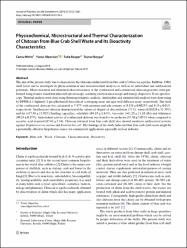| dc.contributor.author | Metin, Cansu | |
| dc.contributor.author | Alparslan, Yunus | |
| dc.contributor.author | Baygar, Tuba | |
| dc.contributor.author | Baygar, Tacnur | |
| dc.date.accessioned | 2020-11-20T14:40:43Z | |
| dc.date.available | 2020-11-20T14:40:43Z | |
| dc.date.issued | 2019 | |
| dc.identifier.issn | 1566-2543 | |
| dc.identifier.issn | 1572-8919 | |
| dc.identifier.uri | https://doi.org/10.1007/s10924-019-01539-3 | |
| dc.identifier.uri | https://hdl.handle.net/20.500.12809/799 | |
| dc.description | baygar, tacnur/0000-0001-8070-0653; ALPARSLAN, Yunus/0000-0002-8833-996X | en_US |
| dc.description | WOS: 000491549500022 | en_US |
| dc.description.abstract | The aim of the present study was to characterize the chitosan synthesized from blue crab (Callinectes sapidus, Rathbun, 1986) shell waste and to investigate its physicochemical and microstructural analyses as well as its antioxidant and antibacterial potentials. Microstructural and elemental characterization of the synthesized and commercial chitosan powders were performed using fourier transform infra-red spectroscopy, scanning electron microscopy and energy dispersive X-ray spectroscopy. Thermal analysis were done using thermogravimetric analysis. Antioxidant and antimicrobial analysis were done using by DPPH (1,1-diphenyl-2-picrylhydrazyl) free radical scavenging assay and agar well diffusion assay, respectively. The yield of the synthesized chitosan was calculated as 7.47% with moisture and ash contents of 0.151 +/- 0.0025% and 0.19 +/- 0.01%, respectively. Synthesized chitosan demonstrated the values of degree of deacetylation (71%), water (620.029 +/- 52.59%) and fat (437.93 +/- 15.92%) binding capacities, solubility (94.15 +/- 2.84%), viscosity (463.25 +/- 13.10 cPs) and whiteness (90.23 +/- 0.27%). Antioxidant activity of synthesized chitosan was found to be moderate (55.30 +/- 5.05%) when compared to ascorbic acid standard (87.61 +/- 1.34). Chitosan obtained from blue crab shell also showed moderate antibacterial activity against Staphylococcus aureus and Escherichia coli. The findings of the study indicated that blue crab shell waste might be a potentially effective biopolymer source for commercial applications especially in food industry. | en_US |
| dc.item-language.iso | eng | en_US |
| dc.publisher | Springer | en_US |
| dc.item-rights | info:eu-repo/semantics/openAccess | en_US |
| dc.subject | Blue Crab | en_US |
| dc.subject | Waste | en_US |
| dc.subject | Chitosan | en_US |
| dc.subject | Characterization | en_US |
| dc.subject | Bioactivity | en_US |
| dc.title | Physicochemical, Microstructural and Thermal Characterization of Chitosan from Blue Crab Shell Waste and Its Bioactivity Characteristics | en_US |
| dc.item-type | article | en_US |
| dc.contributor.department | MÜ, Su Ürünleri Fakültesi, Su Ürünleri Avlama Ve İşleme Teknolojisi Bölümü | en_US |
| dc.contributor.institutionauthor | Metin, Cansu | |
| dc.contributor.institutionauthor | Alparslan, Yunus | |
| dc.contributor.institutionauthor | Baygar, Tuba | |
| dc.contributor.institutionauthor | Baygar, Taçnur | |
| dc.identifier.doi | 10.1007/s10924-019-01539-3 | |
| dc.identifier.volume | 27 | en_US |
| dc.identifier.issue | 11 | en_US |
| dc.identifier.startpage | 2552 | en_US |
| dc.identifier.endpage | 2561 | en_US |
| dc.relation.journal | Journal of Polymers and the Environment | en_US |
| dc.relation.publicationcategory | Makale - Uluslararası Hakemli Dergi - Kurum Öğretim Elemanı | en_US |


















